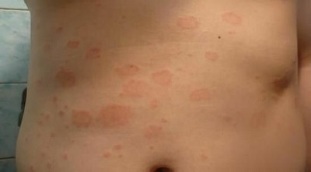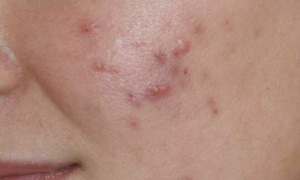
Pictures of psoriasis at an early stage of development can help you identify the disease.
It is very important to understand that in different people the disease can manifest itself in different ways: they differ in degree of intensity, spreading activity, sites of injury and other factors.
The main task is to identify the symptoms and immediately start treating the initial stage of psoriasis.
Early stage characteristics and symptoms
If you know exactly what the early stage of psoriasis looks like, you can literally start treating the condition right away. Early-stage symptoms have characteristic signs, making it possible to treat early-stage psoriasis even before visiting a doctor.
Yes, not everyone has the opportunity to see a dermatologist right away in the initial stage of the disease. Therefore, home treatment with simple means is relevant. It can be folk remedies and recipes, non-hormonal ointments or non-hormonal drugs.
What does psoriasis look like in the early stages of its manifestation? Pay attention to the condition of your skin.
The main signs of early psoriasis are:
- Rash on different parts of the body, with a bright color and light edges. Particularly susceptible to this type of rash are areas of the skin that have recently suffered a burn, a cut or hypothermia. Primary signs can appear between 7 and 14 days after skin damage;
- Peeling on the rash. They are formed in the center of the plates;
- Itching. Psoriatic plaques and papules gradually start to itch. But not all psoriasis is itchy, so these symptoms are not universal. It manifests itself in about half of the patients.
Initially, the papules in the initial stages, that is, the pimples, are very small. Its shape is hemispherical and the surface is smooth and shiny. After a few days, the rashes increase in size and clear scales form over them.
If you scrape these scales of the disease and find three characteristic phenomena, then you can accurately determine that you have psoriasis in the initial stage.
- Stearin stains. The scales should be removed from the surface of the papules very easily, even if you literally touch them a little.
- Movie. The thermal film appears after removing the scales. The skin underneath is red, thin, and moist. The surface of the papule without scales is shiny.
- Rocío. When you have scraped off the scales and removed them, drops of blood will appear in their place.
Initial symptoms usually last several weeks. During this period, it is extremely important to begin effective treatment. If you ignore the disease, the papules can grow up to 3-8 centimeters, merge into a single whole and affect large areas of the skin.
Initial manifestations of psoriasis
The initial stage of the course of the disease is accompanied by localization in different parts of the body. It is almost impossible to predict exactly where psoriasis occurs. But you can accurately identify how psoriasis manifests itself in certain parts of the body during the initial stages of the disease.

Most of the time, they suffer mainly in the first stage:
- Elbows;
- Legs;
- Head;
- Nails;
- Hand;
- Face.
How does psoriasis manifest itself on the body or in other areas?
- Elbows.With ulnar psoriasis, the photos of the initial stage make it clear that here mainly a person is dealing with the plaque form of the disease. The main symptom is small red rashes. The rashes quickly become covered with scales. The skin is very rough.
- Legs.As in the case of the elbows, small rashes form on the legs, gradually increasing in number and increasing in size. Often the first papules are found in the area of the feet or knees. But in some cases, the injuries affect other surfaces of the legs.
- Head.There are two variants of the lesion: the skin or the hairy part. The areas behind the ears and the back of the head are the first to suffer. Papules that form on the head are often accompanied by an unpleasant itch. The papules themselves are characterized by moisture and cracking.
- Nails.The photo allows you to clearly understand that nail psoriasis is in many ways similar to the manifestations of a fungus. First, longitudinal grooves are formed or a kind of depressions appear on the edges of the nails. Then the disease spreads to the roots of the nails. Gradually, the nail plate becomes dull and noticeably thickened. As the disease progresses, the nails gradually shed and fall off the finger. There is little nice about this, so it is strongly recommended to immediately consult a doctor. He will prescribe the appropriate medication for external and internal use.
- Face.Fortunately for many people, especially women, facial psoriasis is a very rare form of the disease. But if you find it, you can determine it by the formation of red papules on the eyelids, lips and nose, near the eyes and eyebrows. Also, psoriasis can appear on the cheeks, forming a fine mesh appearance. Situations of psoriasis neoplasms on the lips, tongue and oral mucosa are extremely rare.
- Hands.If psoriasis affects the hands, the parts that flex (fingers and elbows) are usually the first to suffer. Outwardly, psoriasis on the hands resembles wounds. There are situations of formation of papules on the surface of the palms. In this course of the disease, psoriasis usually affects the feet as well.
Psoriasis treatment techniques

Having discovered the primary signs of the disease, you should immediately consult a doctor and begin to get rid of the disease. The problem for many is that they start treatment late. And the treatment of psoriasis requires a complex, aimed at internal and external effects.
The essence of complex processing is to use several methods simultaneously:
- Medication.Its essence is taking medicine. All of them are divided into hormonal and non-hormonal. In the initial stages, only non-hormonal are prescribed. Only in case of worsening of the situation and acute development of psoriasis, you need to switch to hormonal drugs, antibiotics and other drugs.
- External impact.Here we are talking about the use of ointments, creams and shampoos. In addition, lotions, balms, all kinds of decoctions and baths prepared according to popular recipes are used. Ointments are recognized as the most effective treatment for psoriasis. In this case, the ointments are both hormonal and non-hormonal. As with medications, use only non-hormonal ointments in the initial stages. They are quite effective, but they do not have a number of contraindications and side effects.
- Physiotherapy.The patient may be prescribed ultraviolet radiation, PUVA therapy, electrosleep, or other hospital procedures. Physiotherapy is most effectively treated in sanatoriums and resorts.
- Proper nutrition.It is very important to change your lifestyle if due to the abuse of alcohol, junk food or cigarettes, there is an impetus for the manifestation of the disease. Very often, excluding harmful products and getting rid of addictions, the person's condition normalizes, and psoriasis does not bother for a long time. This is a fact proven in practice.
In the early stages of a disease such as psoriasis, it can be detected and treated. This is the most beneficial scenario for the patient, as it takes a minimum of effort, time and money to suppress psoriasis.























